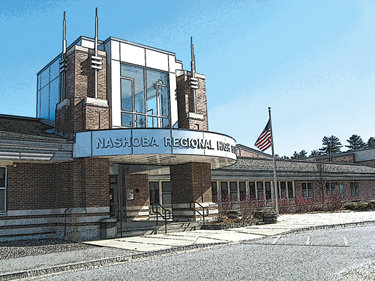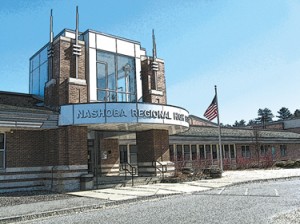
By Ann Needle
The Nashoba School District’s first quarter financial results show that spending is on target, while the School Committee continued to gather information for helping to forecast the 2016/17 budget. Last Wednesday’s SC meeting also featured a glimpse into some new, cutting-edge technology classes at Nashoba Regional High School.
The district’s first quarter financial report carried few surprises, according to Assistant Superintendent George King. While a few areas are overdrawn – for instance, Workers’ Compensation by $38,000 – King assured the committee that most of this will be absorbed by a surplus in the property and casualty insurance budget. He added that any longer-term trends in spending in hard-to-control areas such as Personnel usually become clearer in the second quarter.
Looking ahead, King cautioned that Nashoba may face about a $1.5 million hike in personnel costs in 2016/17, which would be the most significant change for next year. The amount will be better defined after the health insurance policy is renewed at the start of 2016, he noted. He also reported that, next to Personnel, the most volatile budget line tends to be Facilities, which includes such unpredictable items as snow removal.
SC Rep. Neal Darcy of Bolton said that members of the SC Finance Subcommittee will be reporting some information relevant to 2016/17 budget planning for the towns at the Dec. 9 Tri-Town meeting in Stow.
High Tech in NRHS Classrooms
Two Math teachers at NRHS are premiering some new courses designed to propel students into a technology-driven world that, regardless of career choice, will likely value creative computer skills.
“We have a technology-driven economy. Our students need to understand the concepts underlying this so they can participate in that economy,” explained NRHS’s Susan Triantafillou, who teaches the new, semester-long introductory Exploring Computer Science class.
Also new this year is a trial Advanced Placement course, Computer Science Principles, taught by Pat Clark, who spearheaded bringing both computer classes into NRHS. Clark received funding for training from, among other outside sources, the National Science Foundation.
To give SC members a taste of what the classes offer, Triantafillou and Clark distributed tablets to the SC that demonstrated some of the applications students created in AP Computer Science. Clark explained that she chose six of these apps among her 21 students for the SC demonstration, ranging from a beginner’s game centered on a cartoon sheep, to an app for accessing historical statistics for the Red Sox. While creativity was the central criteria in selecting the top apps, Clark noted that other factors came into play – and that “kids were giving their own personalities to this.”
Both teachers agreed the classes target what Clark termed “a broad range of students, especially those typically under-represented.” Clark remarked that, unlike many high-tech offices today, the class hosts many female students, and students from all academic levels participate in both classes.
“I had two kids come up to me in the hallway last year who said they didn’t think they were bright enough for the [AP] class,” Clark said. “Both are now going above and beyond in that class.” Clark said she already has taken some students to a regional programming competition, with plans to attend another in December.
Triantafillou pointed out that both classes teach not just computer programming, but many other valued skills. A few she listed were creativity, problem solving, abstraction, data and information, computational thinking, and the global impact of technology. She predicted that Computer Science will be part of kindergarten through grade 12 education in some form in the near future, when educators will look back and wonder why it was not taught in every grade earlier.
In addition, NRHS Director of Guidance Jodi Specht commented that Computer Science in some form on a high school transcript is becoming desirable – even required – by more colleges.
The presentation received applause from the SC, with Neal Darcy saying to the teachers, “Your eyes are popping, you’re just so motivated.”
Elsewhere around Nashoba, Superintendent Michael Wood reported that needed repairs are beginning on the NRHS Baseball and Softball fields, which were not in the original +$1million Athletic field upgrades of a few years ago. Asked by SC Stow Rep. Lynn Colletti what happened to plans to help defray the cost of the ball field repairs through fundraising, Wood replied, “There was no plan.” But he stressed that rental fees for the fields to non-Nashoba groups should help, along with money budgeted under Maintenance for this school year.
Wood also released more scoring information for the spring 2015 MCAS (go to www.nrsd.net under the School Committee’s 2015/16 meeting materials for Oct. 21). Neal Darcy questioned what could happen with the Math pilot program of this school year (designed to help choose a Math program for the district that is more in line with state standards) if PARCC testing replaces MCAS in any way. “I have no doubt the current framework will stay in place,” Wood maintained, noting that Massachusetts had a substantial influence on PARCC’s development.
In other business, the SC unanimously voted to renew existing policies on the Superintendent’s Contract; Student Searches; and Line Staff and Relations, with minor changes.